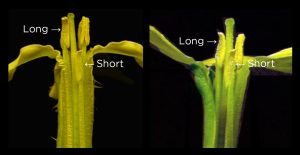Natural selection is usually understood in the context of change. When organisms deviate from the norm, they may gain advantages that let their lineages outlast those of their less-adaptable relatives.
But according to new research from Jeff Conner, KBS researcher and professor in Michigan State University’s Department of Plant Biology in the College of Natural Science, natural selection also has the power to keep things the same.
“We always talk about the vast diversity of life and we should. It’s incredible. Natural selection has given us a lot of that diversity, probably most of it,” said Conner, “but natural selection can also cause similarities.”
Building on prior work
Conner and his team have published a new report in the journal New Phytologist that expands science’s understanding of natural selection in the face of another evolutionary mechanism called genetic constraint.
 The idea behind constraint is that, as species evolve, they can lose genetic flexibility in certain areas. This drives specific traits to stabilize and persist through generations.
The idea behind constraint is that, as species evolve, they can lose genetic flexibility in certain areas. This drives specific traits to stabilize and persist through generations.
This new paper builds on another report from Conner’s group from earlier this year, led by graduate student Robin Waterman. That work was published in the journal Evolution and first hinted that selection could be responsible for conserving traits.
But the researchers still needed to rule out contributions from constraint, which they’ve done in the New Phytologist report.
In both publications, the researchers studied a defining feature of wild radish, which is the length of its stamens, or pollen-producing parts. Two of its six stamens are short and four are long.
Findings
To evaluate the influence of selection and constraint on this family’s distinctive stamen trait, the team turned to what’s called artificial selection. That is, they selectively bred wild radishes whose stamens were closer to the same length to try and change that characteristic.
 The trait responded remarkably quickly. The team reduced the stamen length difference by more than 30% during its experiments.
The trait responded remarkably quickly. The team reduced the stamen length difference by more than 30% during its experiments.
The ancestors of this family had with stamens of equal length and a few species within the family have reverted to equal lengths over the intervening time. But wild radish and the majority of its relatives have evolved — and kept — the four-long, two-short motif likely thanks to natural selection.
“This family of plants has maintained this four-long, two-short trait over 50 million years and we can get rid of a third of the difference in five generations, which would be five years,” Conner said. “My guess is if we kept going, we would get back to six stamens of equal length.”
This work was supported by the National Science Foundation. The research team also included members from Washington State University, Lanzhou University in China, the Napa County Resource Conservation District, Shippensburg University, Auburn University at Montgomery and Reed College.


A legacy of conservation; a commitment to sustainability.
3700 E. Gull Lake Drive
Hickory Corners, MI 49060
(269) 671-5117
info@kbs.msu.edu